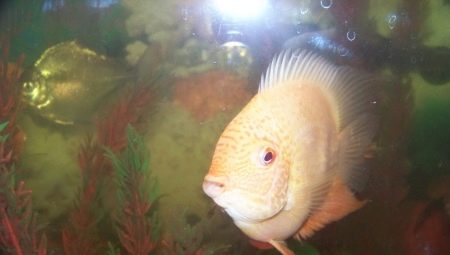Flamingo cichlazoma is one of the most mysterious inhabitants of the aquarium. It is still unknown how this amazing fish was born: in nature or as a result of gene mutation. The content of cichlazoma is not difficult, although it is important to take into account some nuances in this matter.
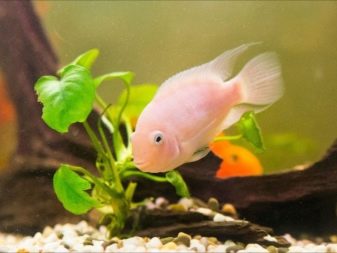
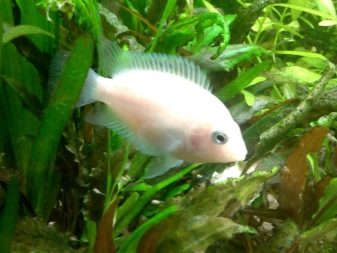
Origin
There are several versions regarding the origin of cichlomas. Some aquarists are inclined to believe that flamingos are an albino of a black-banded cichlase. There is no evidence for this. It is believed that albinos lack color pigment, but flamingo cichlazoma has black eyes and pink color, although being an albino, it should be snow-white.
Other experts are sure that such an interesting fish was obtained as a result of a natural or gene mutation. But there is no clear justification for the version. Anyway this is a very unusual aesthetic creation, which will become a real decoration of the aquarium.

Character and appearance
The mysterious pink cichlazoma has a miniature size. Females are 8 cm long, males can reach a length of 15 cm. The scales have a pinkish tint, which can shimmer under the influence of light and can vary from white to deep pink. Appearance of females and males has differences. So, males differ in a clearly defined frontal part and the presence of bulges on the anal fins.
Females are characterized by a more saturated color, their scales shine like mother of pearl. Especially gender differences are noticeable during the spawning period. The flamingo cichlazoma has large black eyes of a rounded shape with a clear dark frame.
A feature of the nature of cichlomas is ability to recognize your master. Some aquarists say that cichlids take food from their hands, and treat other people more wary. According to the breeders, some individuals even allow themselves to be stroked.
During the spawning period, a peaceful, friendly fish turns into an embittered parent who is ready to engage in battle with anyone who encroaches on the life of her cubs. At this time, flamingos attack both the other inhabitants of the aquarium and the aquarium net lowered by the owner.
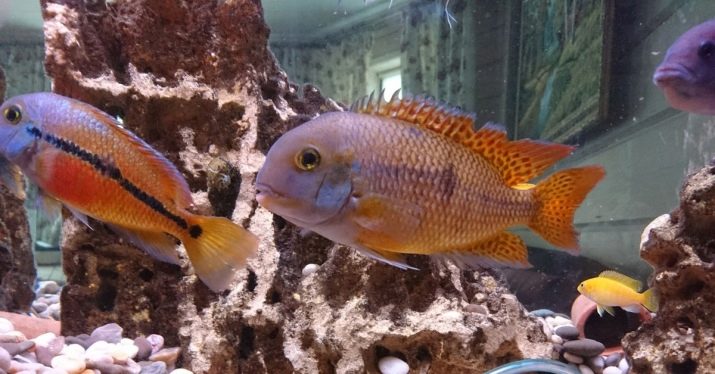
Content
Even a novice breeder can provide the fish with decent conditions. Two fish will require an aquarium of at least 50 liters. At the bottom laid out small pebbles or gravel. It is not recommended to use sand as soil. The fact is that cichlazomas like to dig up the bottom, so the sand will always be dug, the water will quickly become contaminated because of this, daily cleaning will be required.
Equip the aquarium with a heater and set the temperature within 25 degrees. Place the container as far away from the sun as possible, otherwise this will lead to abundant algae bloom. Fill the aquarium with settled water with a hardness of 10–20 ° and an acidity of 6.5–8. Do not forget to get a high-quality filter and compressor that enriches water with oxygen.


Put the grottoes at the bottom. As shelters, caves, driftwood, branches are suitable, even an old ceramic pot will create a mystical atmosphere in the aquarium and will be an excellent object for cichlase games. In addition, during the breeding on the scenery, the fish will lay eggs. These are modest creatures that love to relax in shelter, so do not skimp on the aquarium.
Pick algae with a powerful root system for planting. Firstly, vegetation will become an additional source of food for fish, secondly, it is a very aesthetic decorative element, thirdly, algae are an additional natural filter for water, as some species accumulate particles of dirt on leaves and stems and purify water.
When caring for aquarium pets Do not forget to change one third of the water volume once a week. Depending on the power and type of filter, clean it regularly.
In the case of using an internal filter, cleaning is required 2-3 times a week.
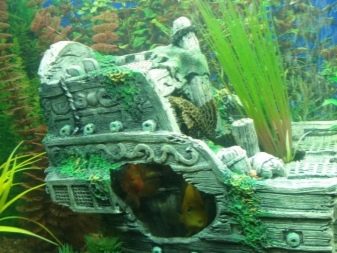

External filters do not need such frequent cleaning, and there is equipment that is sufficient to clean a couple of times a year.
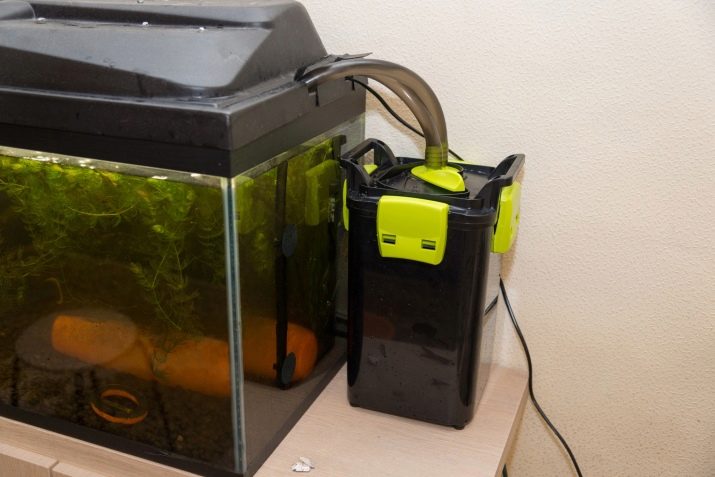
Like all cichlids, a variety of flamingos is distinguished by strong immunity and rarely gets sick. Hole disease, also called hexamitosis, is considered its most common ailment. Symptoms of the disease are defects on the skin of the fish. The cause of the disease can be a decrease in water quality, malnutrition, infection with parasites. Immunity can decrease if the temperature of the water rises above 29 degrees.
To protect cichlases from disease, always quarantine for three weeks when new pets enter the aquarium.
Buy plants from trusted pet stores and reliable breeders. So, for example, the elodea brought from a street reservoir can become a source of infection of fish with parasites and infectious diseases.

Feeding
As food for flamingo cichlomas, bloodworms, tubule, corpetra, artemia are suitable. Do not refuse to use frozen food. A feature of these fish is a tendency to overeat, so feed your pets dosed. All proposed food should be eaten in 10 minutes, all remaining food fragments should be immediately removed by the owner from the aquarium so that they do not pollute the water.
If these are young fish, then you can feed them in large portions, and for adults, on the contrary, it is sometimes important to arrange fasting days. 30% of the menu should be plant foods.
So, dry ready-made feeds containing spirulina algae, cucumbers, zucchini, carrots, lettuce, and spinach are suitable for cichloma.

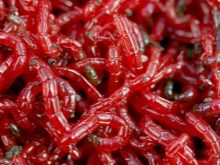
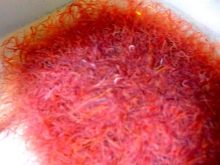
Breeding
Flamingo is ready for the propagation of cichlazoma upon reaching the age of 9-10 months. At this age, fish can already be distinguished by the external sexual characteristics indicated above. As is common with cichlids, this species finds a mate already in adolescence. A pair of converging fish is no longer parted. To obtain offspring, the aquarist selects the best fish specimens and plants them separately. Sometimes for this you have to separate the couple, so this breeding does not always end in success.
To prepare the fish for reproduction of offspring, the water temperature in spawning is increased by several degrees and a change of 30% of the volume of water is performed. For a successful result, it is also customary to feed the fish well with foods high in protein. Do not forget to put shelter in the spawning grounds, a jug or a pot is suitable for this.
First, the formed couple will clean the grotto from the garbage, and then the male will perform a wedding dance in front of his beloved. The female will lay eggs on the surface of the stone. At one time, the female throws about 300 eggs. Then the male fertilizes them.

Cichlids are fish that are able to protect their offspring. So, the next couple of days, the father will begin to swim near the eggs, driving away predators. During this period, he may even show aggression. Therefore, it is recommended that parents be placed during a spawning period in a separate aquarium. When fry are born, the mother begins to care for them, and the male continues to protect them. Over time, their parental instinct disappears and the grown fry themselves can become the prey of their parents, so the mother and father are again transplanted back into the common aquarium.
A 30-liter aquarium with weak aeration is suitable for keeping fry.
Recommended water temperature is 26-30 degrees. Already on the third day, babies can be fed with infusoria or ready-made purchased feeds, then the diet is changed to nauplii artemia.

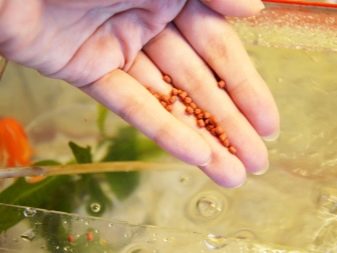
Compatibility
As already mentioned, flamingo cichlomas during the breeding season can harm other inhabitants of the aquarium, therefore it’s better to keep this view separate. Sometimes even relatives can get from parents. The rest of the time, these fish are quite peaceful in nature. They can be kept with most small fish, for example, with other cichlids: apistograms, nannakaras, eliots. Flamingos get along well with brisk schooling fish, for example, barbs.
Very small fish are not suitable for the neighborhood with cichlazoma, otherwise they will become an object of hunting for a curious flamingo.
Therefore, keep such fish as neon, zebrafish, guppy separately. Conflicts in the aquarium are also ensured in the case of colonization of goldfish, laliuses, pecilia, and mollies along with cichlids.
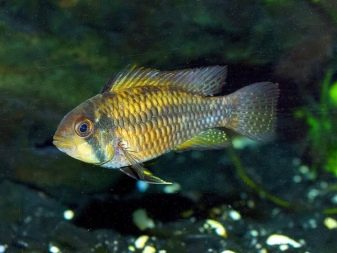
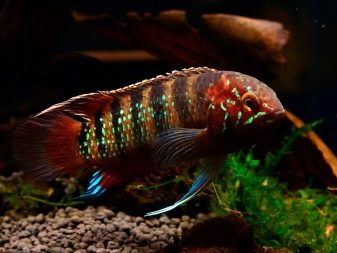
You can look at the flamingo cichlazoma with fry further.
